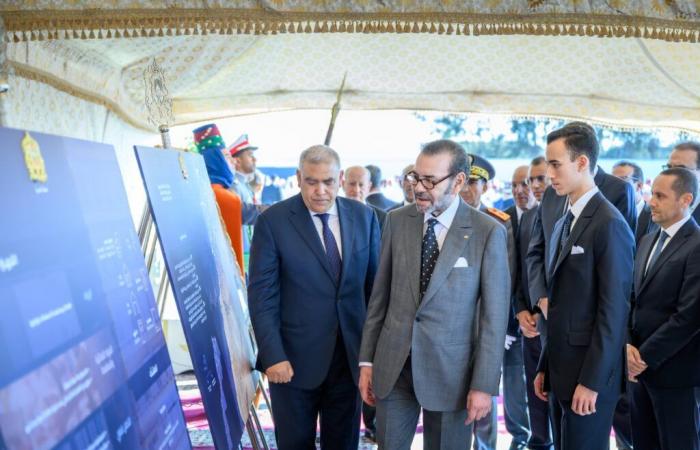Less than a year after the deadly earthquake of Al Haouz, which highlighted the logistical vulnerability of the territories in the face of natural disasters, King Mohammed VI sets the foundations of an unprecedented national resilience. In a world exposed to growing systemic risks – climate change, geopolitical tensions, industrial or health crises – Morocco has a territorial architecture thought to anticipate, store and intervene. The launch of the first regional basin reserves platform marks the starting point for an ambitious logistics network, designed to respond to emergencies with autonomy and efficiency.
King Mohammed VI, accompanied by the Crown Prince Moulay El Hassan, carried out, on Wednesday to the municipality Ameur (prefecture of Salé), to the launch of the construction of the platform of basic necessities of the Rabat-Salé-Kénitra region, a concretization of the Moroccan model of resilience and rapid deployment of help in the event of disasters.
On the orders of the sovereign, each region of the kingdom will have a large basic necessity platform (tents, covers, beds, drugs, foodstuffs, etc.) in order to immediately face disasters (floods, earthquakes, floods, chemical, industrial or radiological risks).
A logistics base for emergency management
The program, presented to the sovereign to the municipality of Ameur (prefecture of Salé), provides for the creation of 12 regional platformsdeployed on a total of 240 hectares. He mobilizes a overall budget of 7 billion dirhamsdont 2 MMDH for infrastructure et 5 MMDH for equipment and stocks. The objective is clear: to constitute Regional strategic reservescapable of immediately meeting the vital needs of the disaster victims, and this, independently and differentiated according to the risks specific to each territory.
A cartography of territorial vulnerabilities
The platforms will be dimensioned according to demographic density and risk typologies. So, six regionsamong the most populated or the most exposed, will have Four warehouses each, with a cumulative area of 20.000 m². These are the regions of Casablanca-Settat, Rabat-Salé-Kénitra, Marrakech-Safi, Fès-Meknès, Tangier-Tétouan-Al Hoceima and Souss-Massa. THE Six other regions will have two warehouses of 10.000 m²adapted to their risk profile: Oriental, Béni Mellal-Khénifra, Drâa-Tafilalet, Guelmim-Oued Noun, Laâyoune-Sakia El Hamra and Dakhla-Oued Ed Dahab.
The pilot platformlaunched today in the capital region, will extend over 20 hectareswith four warehouses, two shelters for equipment outside the size, a heliport and additional logistical spaces. It will be delivered in 12 months.
-An integrated response to multiple disasters
Beyond the logistical approach, the program aims to structure a multisectoral intervention capacity. Stocks will include:
- 200,000 tents and temporary accommodation equipment;
- Unit of mobile kitchens and bakeries, accompanied by food kits;
- Water purification systems and towing electric generators;
- Modular campaign hospitals (6 in first phase, 6 in second), with advanced medical stations and medication reserves;
- Specialized rescue equipment for earthquakes, floods, landslides, chemical or industrial risks.
Inventory management will be provided by specialized teams, according to strict traceability and health security standards.
Synthetic sheet of the royal system
| Section | Detail |
|---|---|
| Title of the project | Regional Participation Platforms |
| Initiator | His Majesty King Mohammed VI |
| Pilot region | Rabat-Salé-Kénitra (Commune Amer, Prefecture of Salé) |
| Total number of platforms planned | 12 platforms |
| Total area mobilized | 240 hectares |
| Budget global | 7 billion dirhams |
| Budget distribution | 2 MMDH for construction, 5 MMDH for equipment and products |
| Duration of realization (pilot platform) | 12 months |
| Composition (densely populated regions) | 4 warehouses of 5,000 m² each (total 20,000 m²) |
| Composition (other regions) | 2 warehouses of 5,000 m² each (total 10,000 m²) |
| Equipment planned | Tents, beds, covers, country hospitals, mobile kitchens, water purifiers, generators, rescue equipment |
| Main objective | Quick deployment of rescue in the event of a natural, technological or industrial disaster |
| Stock management | Ensured by specialized teams, according to strict safety, conservation and traceability standards |
| Expected impact | Coverage equivalent to 3 times the post-seconding needs of Al Haouz; Structuring of a national ecosystem for the production of rescue equipment |
A proactive and structuring vision
This system is part of a long -term royal vision: to make resilience an attribute of sovereignty. He takes note of the teachings of the earthquake of Al Haouz, mentioned as a reference point in the official press release, and aims to cover the equivalent of three times the needs mobilized during this disaster. It also reflects an implicit industrial ambition: promoting the emergence of a national ecosystem for the production of rescue equipment and temporary accommodation.
Towards a Moroccan architecture of crisis management
Designed according to international standards and security criteria, platforms are not only warehouses. They constitute a national civil security infrastructure, thought on a territorial scale, anchored in a differentiated analysis of regional vulnerabilities. Ultimately, they could also support a solidarity foreign policy, positioning Morocco as a logistical player in the humanitarian response in Africa.







